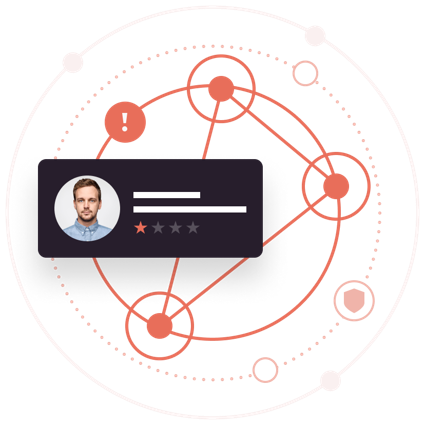
What is first party fraud?
What is First Party Fraud?
The rising cost of living in Australia, resulting from rising interest rates and inflation, is leading to significant amounts of financial stress. Recent data from the Australian Bureau of Statistics showed prices climbing by 6.1% in the June quarter (the fastest annual pace in almost 20 years) driven primarily by the increasing cost of food and fuel.
In some situations, individuals in challenging financial situations may find themselves thinking of ways to make ends meet — or simply losing track of their financial footprint as the desperation to find savings or obtain loans intensifies.
First Party Fraud describes a situation where an individual purposefully or accidently omits or misrepresents information, usually for a financial gain. As an example, an individual may omit expenses or liabilities to obtain an account or credit; or not disclosing some information to obtain a better price or premium for an insurance policy.
First Party Fraud can be opportunistic, sometimes a split-second decision to try and wrangle additional funds or another financial benefit. Other times, it can be planned in advance or following an event. For example, an individual may apply for a credit card and not disclose their liabilities following a decline of an application where they have disclose all liabilities. In other circumstances, an individual may not disclose their child as the main driver on an insurance policy knowing it is likely to cause a high premium.
The reasons to commit First Party Fraud are varied. At times, an individual may lie about their circumstances to save a few dollars on an insurance premium. Other times, the intention might be to defraud an organisation of tens of thousands of dollars. The level of sophistication would vary based on the intent and the perceived gain.
Individuals may go to significant effort to understand how to commit a particular fraud or simply lie without much of a consideration. This can make it challenging for organisations to identify First Party Fraud. But one thing for sure, no business is immune to the challenges of First Party Fraud and should therefore invest in prevention and detection of the First Party Fraud.
How does First Party Fraud typically occur?
First Party Fraud is different to Third Party Fraud as it usually involves a person’s own identity and details. Unlike Third Party Fraud, where the offender would usually use stolen identity details, a First Party Fraud offender does not try to hide their actual identity.
The fraudster in question is the genuine holder of the information but is knowingly falsely claiming and misrepresenting their circumstances and financial situation for personal financial gain.
Some other common examples of First Party Fraud include:
- Application fraud, when financial products such as mortgages or loans are applied for using false information or supporting documentation.
- Chargeback fraud, when there is a fraudulent attempt to secure a refund using the chargeback process and subsequent dispute with their bank.
- Sleeper fraud, also known as Bust-out fraud is when an individual acquires credit insidiously over a long period of time, building up what appears to be regular customer behaviour. As the customer builds trust with the service provider over months or even years, they eventually ask for more credit and then cash in, taking the maximum amount of cash and any goods with them, never to be seen again.
Prevent financial crime at the point of origin

The knock on impact of First Party Fraud for businesses
Globally, the increasing digitisation of business has led to a surge in suspected digital fraud attempts, with a 17% rise in Q2 2021 from the same quarter in 2020, according to TransUnion. Gaming and the travel and leisure industries were the most impacted, with suspected digital fraud attempts rising 393% and 155% in 2021 respectively. While much of the fraud is the result of Third Party Fraud, the perceived anonymity of digital channels makes some individuals more likely to commit fraud than if they had to do the same in a face-to-face environment.
First Party Fraud can be a low volume, high value form of fraud, especially when it extends beyond an everyday consumer telling a ‘white lie’.
In yet another compounding issue for businesses dealing with the increasingly sophisticated First Party Fraud and processes automation, detection can be notoriously difficult. Often, pre-existing silos within organisations can provide First Party fraudsters with an opportunity to not get detected and often commit the same fraud over and over again. In a financial services organisation, a lack of effective communication between collections and fraud departments can make fraud go unnoticed.
That’s why end-to-end fraud management platform readiness, like the application fraud technology provided by GBG, is so vital. A recent study by GBG found vertical silos still exist in 43% of APAC financial institutions, and these are most prevalent in digital banks.
Detect complex fraud with predictive analytics and deep learning

How likely are Australians to commit First Party Fraud?
In order to better understand the prevalence of First Party Fraud in Australia, GBG conducted a survey of 1,008 consumers in July 2022 to assess how ongoing financial stress plays a role. The findings were analysed in a report called The Evolution of First Party Fraud in Australia.
Around half of Australians surveyed said the likelihood of them applying for a financial service or loan in the next 12 months in response to the rising cost of living is unchanged. 14% were more likely to apply, and 33% were less likely.
- Despite growing financial pressures, 89% of Australians said they are unchanged or less likely to omit a debt or other liability in a financial service or loan application over the next 12 months
- 81% of Australians said they would be 100% accurate about how much debt they have.
- 70% said they would never knowingly lie in a financial service or loan application.
- Almost one in five (19%) of Australians believe it is OK to tell a ‘white lie’ and report having less debt than they actually have in a financial service or loan application
The research suggests while most Australians appear to be taking responsibility in acting honestly with their financial providers, the minority who think it is ok to commit First Party Fraud is not a negligible amount and may grow as financial pressures mount over time.
GBG is a world leader in detecting and managing application fraud. Its proven and proactive application fraud defence identifies up to 30% more online fraud, with layered intelligence and advanced analytics to minimise the losses from financial fraud for businesses.
It also improves customer onboarding efficiency and builds digital trust with customers — after all, there is no point in integrating digital identity verification checks if it is just going to alienate potential valid customers. Using a precise and real-time risk detection model, the decisioning solutions mitigate fraud risk whilst ensuring a smooth user experience for customers at the same time.
This is the first in a three-part blog series about First Party Fraud. Stay tuned for Parts 2 and 3.
To find out more about how GBG can help your organisation address the growing complexity of fraud visit https://www.gbgplc.com/apac/application-fraud/
To read the full GBG report, “The Evolution of First Party Fraud in Australia” https://www.gbgplc.com/apac/fraud-compliance-management/evolution-of-first-party-fraud-in-australia/
Sign up for more expert insight
Hear from us when we launch new research, guides and reports.


